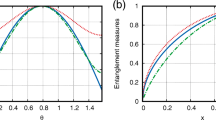Abstract
We reexamine quantum correlation from the fundamental perspective of its consanguineous quantum property, the coherence. We emphasize the importance of specifying the tensor product structure of the total state space before discussing quantum correlation. A measure of quantum correlation for arbitrary dimension bipartite states using nonlocal coherence is proposed, and it can be easily generalized to the multipartite case. The quantification of non-entangled component within quantum correlation is investigated for certain states.




Similar content being viewed by others
References
Einstein, A., Podolosky, B., Rosen, N.: Phys. Rev. 47, 777 (1935)
Schrödinger, E.: Naturwissenschaften 23, 807 (1935)
Horodecki, R., Horodecki, P., Horodecki, M., Horodecki, K.: Rev. Mod. Phys. 81, 865 (2009)
Werner, R.F.: Phys. Rev. A 40, 4277 (1989)
Bennett, C.H., DiVincenzo, D.P., Fuchs, C.A., Mor, T., Rains, E., Shor, P.W., Smolin, J.A., Wootters, W.K.: Phys. Rev. A 59, 1070 (1999)
Horodecki, M., Horodecki, P., Horodecki, R., Oppenheim, J., Sen, A., Sen, U., Synak-Radtke, B.: Phys. Rev. A 71, 062307 (2005)
Niset, J., Cerf, N.J.: Phys. Rev. A 74, 052103 (2006)
Braunstein, S.L., Caves, C.M., Jozsa, R., Linden, N., Popescu, S., Schack, R.: Phys. Rev. Lett. 83, 1054 (1999)
Meyer, D.A.: Phys. Rev. Lett. 85, 2014 (2000)
Biham, E., Brassard, G., Kenigsberg, D., Mor, T.: Theor. Comput. Sci. 320, 15 (2004)
Datta, A., Flammia, S.T., Caves, C.M.: Phys. Rev. A 72, 042316 (2005)
Datta, A., Vidal, G.: Phys. Rev. A 75, 042310 (2007)
Henderson, L., Vedral, V.: J. Phys. A 34, 6899 (2001)
Ollivier, H., Zurek, W.H.: Phys. Rev. Lett. 88, 017901 (2001)
Oppenheim, J., Horodecki, M., Horodecki, P., Horodecki, R.: Phys. Rev. Lett. 89, 180402 (2002)
Groisman, B., Popescu, S., Winter, A.: Phys. Rev. A 72, 032317 (2005)
Luo, S.: Phys. Rev. A 77, 022301 (2008)
Luo, S.: Phys. Rev. A 77, 042303 (2008)
Modi, K., Paterek, T., Son, W., Vedral, V., Williamson, M.: Phys. Rev. Lett. 104, 080501 (2010)
Yu, C.-S., Song, H.-S.: Phys. Rev. A 80, 022324 (2009)
Zanardi, P., Lidar, D., Lloyd, S.: Phys. Rev. Lett. 92, 060402 (2004)
Wootters, W.K.: Phys. Rev. Lett. 80, 2245 (1998)
Ali, M., Rau, A.R.P., Alber, G.: Phys. Rev. A 81, 042105 (2010)
Hill, S., Wootters, W.K.: Phys. Rev. Lett. 78, 5022 (1997)
Ali, M.: J. Phys. A, Math. Theor. 43, 495303 (2010)
Chi, D.P., Lee, S.: J. Phys. A, Math. Gen. 36, 11503 (2003)
Coffman, V., Kundu, J., Wootters, W.K.: Phys. Rev. A 61, 052306 (2000)
Dür, W., Vidal, G., Cirac, J.I.: Phys. Rev. A 62, 062314 (2000)
Pathak, P.K., Hughes, S.: Phys. Rev. B 83, 245301 (2011)
Akopian, N., Lindner, N.H., Poem, E., Berlatzky, Y., Avron, J., Gershoni, D., Gerardot, B.D., Petroff, P.M.: Phys. Rev. Lett. 96, 130501 (2006)
Zhou, T., Cui, J., Long, G.L.: Phys. Rev. A 84, 062105 (2011)
Author information
Authors and Affiliations
Corresponding author
Appendix: Proof for the Existence of Unitaries to Produce \(\mathcal{L}(\rho)=0\)
Appendix: Proof for the Existence of Unitaries to Produce \(\mathcal{L}(\rho)=0\)
Consider an arbitrary local unitary operation U 1 performing on the first subsystem ρ 1 of the bipartite system ρ, it produces

On the other hand, perform arbitrary local unitary operations U 1 and U 2 on the two subsystems, respectively. Then tracing out the second subsystem will produce the reduced density matrix of the first subsystem as

Therefore, \(\operatorname{tr}_{2}\{(U_{1}\otimes{U_{2}})\rho(U_{1}^{\dagger}\otimes {U_{2}^{\dagger}})\}=U_{1}\rho_{1}U_{1}^{\dag}\). Similarly, one can obtain
There exists always unitary operation U 1d , U 2d to diagonalize the subsystem ρ 1, ρ 2, thus under these specific unitary operations Eq. (13) and Eq. (14) give
where \(\rho_{ikik}^{c}\) is the diagonal element of subsystem \(\rho _{1}^{(d)}\), \(\rho_{2}^{(d)}\) transformed by the local unitary operations. Since \(\rho_{1}^{(d)}\), \(\rho_{2}^{(d)}\) is diagonal, the off-diagonal elements are vanishing, giving
Therefore for bipartite system, there exist always local unitaries to produce \(\mathcal{L}(\rho)=0\).
Rights and permissions
About this article
Cite this article
Pei, P., Wang, W., Li, C. et al. Using Nonlocal Coherence to Quantify Quantum Correlation. Int J Theor Phys 51, 3350–3358 (2012). https://doi.org/10.1007/s10773-012-1215-6
Received:
Accepted:
Published:
Issue Date:
DOI: https://doi.org/10.1007/s10773-012-1215-6



